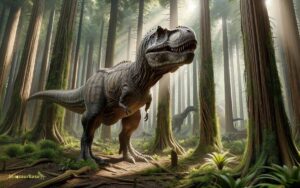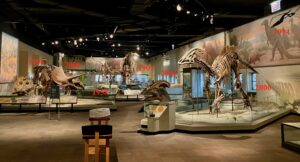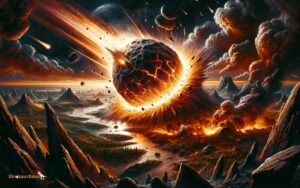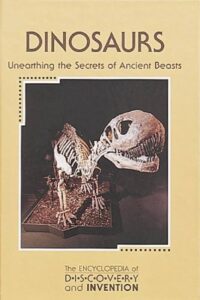What Dinosaur Is Godzilla
Wading through the depths of cinematic history, Godzilla emerges as a colossus straddling the line between prehistoric myth and modern nightmare. Initially inspired by the towering Tyrannosaurus Rex, the creature's lineage has sparked debates among fans and scholars alike.
The introduction of the Godzillasaurus in later narratives added layers to its origins, blending elements of various dinosaurs and even marine reptiles to craft a behemoth that defies simple classification. As the discussion veers into the realms of the Iguanodon's influence and beyond, one can't help but wonder about the true prehistoric blueprint of this iconic monster.
Unraveling Godzilla's complex genetic tapestry promises to shed light on the fascinating interplay between science fiction and paleontological fact.
Key Takeaways
- Godzilla was initially inspired by the Tyrannosaurus Rex, reflecting its destructive force and primordial rage.
- The design of Godzilla blends elements from various dinosaurs, including traits from theropods and marine reptiles.
- Godzillasaurus serves as a transitional figure, bridging Godzilla's evolution from prehistoric inspirations to the iconic monster.
- While Godzilla's design is influenced by real dinosaurs, it is a fictional creation that emphasizes the catastrophic power of nature.
Godzilla's Early Concepts
In conceptualizing Godzilla, the creators initially drew inspiration from prehistoric dinosaurs, aiming to embody the catastrophic power of nature through a colossal, reptilian monster. This conception was deeply rooted in a desire to visualize the sheer force and unpredictability inherent in natural disasters, paralleling these characteristics with those of ancient, formidable creatures that once roamed the Earth.
The creative team meticulously researched various dinosaur species, analyzing their physical attributes and behaviors to craft a creature that could resonate with these themes of power and primordial rage. They envisioned Godzilla as an amalgamation of multiple dinosaurs, incorporating aspects that would emphasize its role as a destructive force, yet ensuring it remained a symbol of the awe-inspiring mystery that surrounds the prehistoric past.
The Tyrannosaurus Rex Connection
Building on the foundation of Godzilla's prehistoric inspirations, the Tyrannosaurus Rex emerges as a pivotal influence in shaping the monster's ferocious appearance and predatory demeanor. The Tyrannosaurus Rex, known for its massive body, powerful jaws, and sharp teeth, mirrors Godzilla's own intimidating presence.
This iconic dinosaur has long captivated the public's imagination as the apex predator of the Cretaceous period, making it a natural reference point for Godzilla's creators aiming to embody ultimate power and aggression. The T-Rex's influence extends to Godzilla's bipedal stance and robust tail, elements that enhance the monster's ability to dominate both land and sea.
This connection underscores the creative process of blending scientific discovery with imaginative design to craft a creature that resonates with audiences' primordial fears and fascinations.
Introducing the Godzillasaurus
Delving deeper into Godzilla's prehistoric roots, we encounter the fictional creature known as Godzillasaurus, a pivotal link in the monster's evolutionary narrative. This entity serves as a crucial transitional figure, bridging the gap between Godzilla's imagined prehistoric origins and its contemporary manifestations.
Unlike the real-life Tyrannosaurus Rex, to which it bears a superficial resemblance, Godzillasaurus is portrayed with distinct characteristics that foreshadow Godzilla's iconic features. It stands as a testament to the creature's complex backstory, ingeniously crafted by its creators to provide a plausible pre-transformation state.
Analyzing Godzillasaurus reveals insights into the creative process behind Godzilla's design, illustrating how speculative evolution is employed to craft a narrative that resonates with the monster's legendary status while sparking intrigue about its ancient past.
Beyond the T-Rex: Other Influences
While the Tyrannosaurus Rex's influence on Godzilla's design is undeniable, a closer examination reveals a blend of traits from various prehistoric creatures, notably marine reptiles and theropods.
Godzilla's aquatic prowess and dorsal fins suggest an inspiration drawn from ancient marine reptiles, pointing to a hybridization of terrestrial and aquatic characteristics.
Moreover, the creature's bipedal stance and predatory features highlight theropod traits, underscoring a complex ancestry beyond the iconic T-Rex.
Marine Reptile Origins
Exploring the marine reptile origins of Godzilla reveals a fascinating blend of influences beyond the iconic Tyrannosaurus Rex, encompassing a diverse array of prehistoric aquatic creatures. Godzilla's design, particularly its dorsal fins, suggests a kinship with creatures like the Ichthyosaurs and Plesiosaurs, marine reptiles that thrived in the Mesozoic Era.
These animals weren't dinosaurs but shared the same prehistoric epoch. Ichthyosaurs, resembling large fish or dolphins, were swift and powerful swimmers. Their streamlined bodies and fin-like appendages hint at Godzilla's aquatic abilities and menacing silhouette in the water.
Plesiosaurs, with their long necks and flippers, contribute to Godzilla's unique body structure and flexibility, allowing for a portrayal that's both terrifying and eerily realistic in its prehistoric echoes.
Godzilla's Theropod Traits
Although primarily associated with the Tyrannosaurus Rex, Godzilla also exhibits traits characteristic of other theropods, underscoring a diverse prehistoric influence. This diversity reflects not just a singular inspiration but a mosaic of the theropod group's most formidable members. To appreciate Godzilla's composite nature, consider the following traits:
- Spinosaurus-like sail or ridges: Suggesting a resemblance to the distinctive dorsal features of Spinosaurus.
- Allosaurus-inspired skull structure: Indicating a broader and more robust head similar to that of Allosaurus.
- Velociraptor-esque agility: Despite its size, Godzilla demonstrates agility reminiscent of smaller, more nimble theropods.
- Carnotaurus-like arms: Short but seemingly powerful limbs hint at a similarity to the reduced forelimbs of Carnotaurus.
These traits contribute to Godzilla's portrayal as an apex predator, mirroring the evolutionary success of theropods.
The Iguanodon's Role
The Iguanodon, a significant dinosaur in the study of paleontology, presents unique physical characteristics that contribute to its iconic status in pop culture. Its distinct thumb spikes and bipedal posture offer fascinating contrasts when comparing to Godzilla's design and fictional abilities.
This analysis will explore how the Iguanodon's attributes and its representation in media have influenced perceptions of dinosaurs, including the king of monsters himself.
Iguanodon's Physical Characteristics
Iguanodon's distinct physical characteristics, including its large thumb spikes and robust herbivorous teeth, played a crucial role in its survival and ecological interactions during the Early Cretaceous period. These unique features not only allowed Iguanodon to efficiently process a variety of plant materials but also provided defense mechanisms against predators.
- Large Thumb Spikes: Used for defense and possibly for foraging.
- Robust Herbivorous Teeth: Adapted to grinding plant material, indicating a versatile diet.
- Bipedal and Quadrupedal Locomotion: Could walk on two legs or move on all fours, enhancing mobility and feeding options.
- Strong Tail: Contributed to its balance and speed, essential for escaping predators.
These adaptations underline Iguanodon's success in navigating its environment, securing food sources, and avoiding predators, marking it as a versatile and resilient dinosaur of its time.
Iguanodon in Pop Culture
Moving beyond its significant biological traits, Iguanodon has also made a notable impact within the realm of popular culture, capturing the imagination of audiences through various media portrayals. Its distinct appearance, characterized by a large thumb spike and bipedal stance, has made it a subject of fascination.
This dinosaur has appeared in literature, film, and video games, often depicted as both a formidable creature and a symbol of prehistoric life's diversity. Its inclusion in these mediums serves not only to entertain but also to educate the public about the Mesozoic era.
Comparing Iguanodon and Godzilla
Exploring the contrasts and similarities between Iguanodon and Godzilla reveals significant insights into the intersection of paleontology and pop culture. While Iguanodon, a real dinosaur discovered in the early 19th century, shares limited physical similarities with Godzilla, a fictional monster created in the mid-20th century, the comparison yields fascinating discussions on creature design and the influence of scientific discoveries on media.
- Physical Characteristics: Unlike Godzilla's reptilian, bipedal stance and atomic breath, Iguanodon was a quadrupedal herbivore with distinctive thumb spikes.
- Cultural Impact: Godzilla has become an international icon of destruction, whereas Iguanodon's role in scientific history marks the dawn of dinosaur paleontology.
- Influence on Media: Godzilla's appearances in films contrast with Iguanodon's quieter presence in museums and educational materials.
- Scientific Accuracy: Godzilla's design owes more to fantasy than to the fossil record, unlike the rigorously studied and depicted Iguanodon.
Marine Reptiles and Godzilla
Among the myriad of connections drawn between Godzilla and prehistoric creatures, the comparison with marine reptiles offers intriguing insights into the evolutionary and fictional aspects of this iconic monster.
Godzilla's aquatic abilities and design have often been likened to that of ancient marine reptiles, such as the Plesiosaurs and Mosasaurs, which dominated the prehistoric oceans. These reptiles exhibited powerful swimming capabilities, streamlined bodies, and were apex predators in their environments, characteristics that Godzilla mirrors in his cinematic portrayals.
Furthermore, Godzilla's ability to thrive both in water and on land echoes the adaptability seen in some marine reptiles, suggesting an evolutionary bridge between aquatic and terrestrial life.
This comparison not only enriches the lore surrounding Godzilla but also highlights the creature's roots in natural history, bridging fiction with paleontological facts.
Godzilla's Evolution in Cinema
Godzilla's cinematic journey reflects a dynamic evolution, showcasing the monster's transformation from a symbol of post-war trauma to a global pop culture icon. This evolution is marked by:
- Variations in Design: From its initial terrifying depiction, Godzilla's appearance has been modified to suit changing audience tastes and advancements in special effects technology.
- Shift in Genres: Godzilla's films have transitioned from horror and sci-fi to include action and even elements of comedy, broadening its appeal.
- Character Development: Initially an antagonist, Godzilla has evolved into a complex character, sometimes even portrayed as a hero defending Earth.
- Global Influence: The franchise's expansion into international markets has influenced its narrative and visual style, reflecting a blend of cultural influences.
This intricate evolution highlights Godzilla's enduring relevance and adaptability in cinema.
Mythological and Fictional Inspirations
Building on Godzilla's cinematic journey, it's crucial to examine the mythological and fictional inspirations that have shaped this iconic monster's creation and enduring appeal. The concept of Godzilla, while seemingly novel, draws heavily from an amalgamation of mythological creatures and literary monsters.
In many cultures, dragons and sea monsters embody nature's uncontrollable power, echoing Godzilla's role as a force of nature. Additionally, Godzilla's narrative arc mirrors that of ancient myths where gods and monsters symbolize natural disasters and human folly.
The creature's design and characteristics also nod to the prehistoric fascination embedded in literature, showcasing a blend of various dinosaurs and fictional beasts. This synthesis of mythological and literary elements not only enhances Godzilla's mystique but also enriches its cultural significance, making it a modern mythological figure.
Godzilla's Scientific Plausibility
Delving into the realm of scientific speculation, it's clear that Godzilla's existence, while fascinating, presents several implausibilities when examined through the lens of contemporary biology and physics.
- Square-Cube Law: As size increases, volume (and thus weight) grows faster than surface area, leading to insurmountable structural and metabolic challenges for Godzilla-sized creatures.
- Metabolic Demands: The energy required to fuel a creature of Godzilla's magnitude would far exceed what could feasibly be obtained through any known diet.
- Skeletal Structure: To support its massive weight, Godzilla would need bones made from materials far stronger and lighter than anything biological.
- Radiation as a Power Source: Although radiation is a potent force, the idea that it could be directly harnessed to sustain life or grant extraordinary powers lacks scientific support.
Conclusion
In conclusion, Godzilla emerges as a cinematic chimera, blending elements from the Tyrannosaurus Rex, Iguanodon, and various marine reptiles.
But does this fusion render Godzilla scientifically plausible? While the creature's origins in the Godzillasaurus nod towards a semblance of paleontological accuracy, the amalgamation of mythological and fictional influences distances Godzilla from scientific reality.
Ultimately, Godzilla transcends the boundaries of paleontology, embodying a creature that's as fascinating as it's improbable in the natural world.




